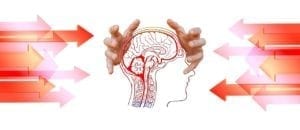Hemiplegic Migraine
What is a hemiplegic migraine?
Hemiplegic migraine (either familial or sporadic) is a rare and serious type of a migraine headache, and like migraines, it causes intense and throbbing pain, nausea, and sensitivity to light and sound. However, other symptoms of a hemiplegic migraine are similar to those of a stroke, and they start before the headache. (“Hemiplegia” means paralysis).What causes a hemiplegic migraine?
As of yet, researchers have found three genes linked with hemiplegic migraine: the CACNA1A gene, the ATP1A2 gene, and the SCN1A gene. Mutations in any of these genes can inhibit the body from making a certain protein that sends serotonin. Due to the genetic nature of hemiplegic migraines, most people afflicted with this condition inherited the faulty genes from a parent who also has the condition, although some develop it sporadically.What are the symptoms of a hemiplegic migraine?
In hemiplegic migraine, signs of the actual headache will come as early symptoms of the disease, called auras, that usually last from five minutes to an hour. These include short-term trouble with muscle control and sensation:- Severe, throbbing pain
- A pains-and-needles feeling
- Numbness, weakness, or paralysis on one side of the body
- Loss of balance and coordination
- Dizziness or vertigo, nausea and vomiting
- Seeing zigzag lines, double vision, or blind spots
- Slurred speech or language difficulties
- Confusion or loss of consciousness
- Extreme sensitivity to light, sound, and smell
How is a hemiplegic migraine diagnosed?
Hemiplegic migraine is diagnosed beginning with a thorough clinical examination and patient and family history, as well as a discussion of the patient’s symptoms. A CT scan or an MRI of the patient’s head can show signs of a stroke, and heart and blood vessel tests can rule out blood clots. Genetic testing can help confirm a diagnosis.What are the available treatments for a hemiplegic migraine?
Apparently, there are disagreements over how to treat hemiplegic migraines, but many doctors are feeling more comfortable using drugs called triptans, which are traditionally used for normal migraines, for hemiplegic migraines, as well. In addition to triptans, anticonvulsants and calcium channel blockers may also be prescribed, which are traditionally used for seizures, bipolar disorder, and heart conditions, respectively.Where can I find more information on hemiplegic migraines?
Hemiplegic Migraine Articles


Therapy Dogs can be Life-Changing for Those with Hemiplegic Migraine
Trudy Horsting
July 22, 2020
Read More »


Recent Study Highlights the Genetic Basis of Hemiplegic Migraines
James Moore
May 15, 2018
Read More »



